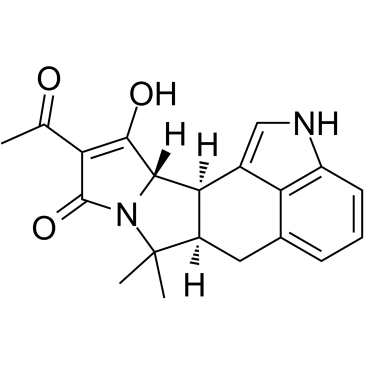Cyclopiazonic acid (Synonyms: NSC 117181) |
| Catalog No.GC10268 |
sarcoplasmic reticulum Ca2+-ATPase inhibitor
Products are for research use only. Not for human use. We do not sell to patients.

Cas No.: 18172-33-3
Sample solution is provided at 25 µL, 10mM.
Cyclopiazonic acid is a mycotoxin produced by molds including certain species of Penicillium and Aspergillus. Its toxicity is linked to its ability to specifically and reversibly inhibit sarco-endoplasmic reticulum Ca2+-ATPases (SERCA; IC50 = 0.6 μM).[1],[2] Cyclopiazonic acid does not inhibit a wide variety of other types of membrane-bound ATPases. It effectively inhibits SERCA in intact tissue, in smooth muscle and endothelium, as well as in isolated cells.[3],[4]
References
[1]. Seidler, N.W., Jona, I., Vegh, M., et al. Cyclopiazonic acid is a specific inhibitor of the Ca2+-ATPase of sarcoplasmic reticulum. The Journal of Biological Chemisty 264(30), 17816-17823 (1989).
[2]. Uyama, Y., Imaizumi, Y., and Watanabe, M. Effects of cyclopiazonic acid, a novel Ca2+-ATPase inhibitor, on contractile responses in skinned ileal smooth muscle. British Journal of Pharmacology 106, 208-214 (1992).
[3]. Mumtaz, S., Burdyga, G., Borisova, L., et al. The mechanism of agonist induced Ca2+ signalling in intact endothelial cells studied confocally in in situ arteries. Cell Calcium 49(1-4), 66-77 (2011).
[4]. Berra-Romani, R., Raqeeb, A., Torres-Jácome, J., et al. The mechanism of injury-induced intracellular calcium concentration oscillations in the endothelium of excised rat aorta. Journal of Vascular Research 49, 65-76 (2012).
Average Rating: 5 (Based on Reviews and 2 reference(s) in Google Scholar.)
GLPBIO products are for RESEARCH USE ONLY. Please make sure your review or question is research based.
Required fields are marked with *




